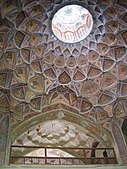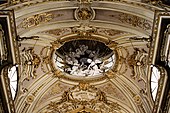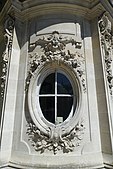Oculus (architecture)

Anoculus(fromLatinoculus'eye';pl.:oculi) is a circular opening in the center of adomeor in a wall. Originating inantiquity,it is a feature ofByzantineandNeoclassical architecture.It is also known as anœil-de-bœuffrom theFrench,or simply a "bull's-eye".[2]
History[edit]
Classical[edit]
The oculus was used by theAncient Romans,one of the finest examples being that in the dome of thePantheon.Open to the weather, it allows rain and air to enter and fall to the floor, where it is carried away through drains. Though the opening looks small, it actually has a diameter of 8.7 m (29 feet), allowing it to light the building.
Byzantine[edit]
The oculus was widely used in the architecture of theByzantine Empire.It was applied to buildings inSyriain the 5th and 6th centuries and again in the 10th century. InConstantinople'sMyrelaion Church(c. 920), there are two oculi above thestringcourseon both lateral facades.[3]
Renaissance[edit]
Early examples of the oculus inRenaissance architecturecan be seen inFlorence Cathedral,in the naveclerestoryand topping the crowns of the arcade arches.[4]
Neoclassical[edit]
Since the revival of dome construction beginning in theItalian Renaissance,open oculi have been replaced by light-transmittingcupolasand other round windows, openings, andskylights.They can be seen in the pediments ofPalladio'sVilla Rotonda,though not in the dome. Use of oculus windows became more popular inBaroque architecture.Widely used byNeo-Palladianarchitects includingColen Campbell,one can be seen in the dome ofThomas Jefferson'sRotundaat theUniversity of Virginia.[2][5]
Examples[edit]
-
Rococooculus in the Parc de Bagatelle (Paris)
-
Louis XVIround window of thePetit Trianon(Versailles,France), with afestoon-derived ornament at the top
-
19th centuryEclecticClassicist oculus of theOpéra-Théâtre de Clermont-Ferrand,Clermont-Ferrand,France
-
Beaux-Artsdormeroculus of the Building of Préfecture de Police de Paris, Île de la Cité
-
Art Nouveauoculus of theHôtel Élysée Palace,Paris
References[edit]
- ^Bresc-Bautier, Geneviève (2008).The Louvre, a Tale of a Palace.Musée du Louvre Éditions. p. 122.ISBN978-2-7572-0177-0.
- ^ab"Oculus window".Royal Institute of British Architects.March 27, 2014. Archived fromthe originalon March 27, 2014.Retrieved24 January2014.
- ^Ćurčić, Slobodan; Johnson, Mark Joseph; Ousterhout, Robert G.; Papalexandrou, Amy (1 January 2012).Approaches to Byzantine Architecture and Its Decoration: Studies in Honor of Slobodan Ćurčić.Ashgate Publishing. pp. 148–.ISBN978-1-4094-2740-7.Retrieved24 January2013.
- ^"The Cathedral of Santa Maria del Fiore, Florence".muohio.edu.March 27, 2014. Archived fromthe originalon March 27, 2014.Retrieved24 January2013.
- ^"Daylighting in two centroidal spaces at the University of Virginia: Case Study, The Rotunda and Caplin Pavilion".TheUniversity of Virginia.Retrieved24 January2013.
External links[edit]
![]() The dictionary definition ofoculus (architecture)at Wiktionary
The dictionary definition ofoculus (architecture)at Wiktionary



![Romanesque oculus of the Église Sainte-Anne de Gassicourt [fr], Mantes-la-Jolie, France](https://upload.wikimedia.org/wikipedia/commons/thumb/0/04/Gassicourt_Sainte-Anne_327.JPG/170px-Gassicourt_Sainte-Anne_327.JPG)






![19th century Eclectic Classicist oculus of the Opéra-Théâtre de Clermont-Ferrand [fr], Clermont-Ferrand, France](https://upload.wikimedia.org/wikipedia/commons/thumb/c/c0/Op%C3%A9ra_municipal_de_Clermont-Ferrand%2C_%C5%93il_de_b%C5%93uf.jpg/170px-Op%C3%A9ra_municipal_de_Clermont-Ferrand%2C_%C5%93il_de_b%C5%93uf.jpg)

![Art Nouveau oculus of the Hôtel Élysée Palace [fr], Paris](https://upload.wikimedia.org/wikipedia/commons/thumb/7/76/Louis_Baralis_HSBC_1.jpg/127px-Louis_Baralis_HSBC_1.jpg)
